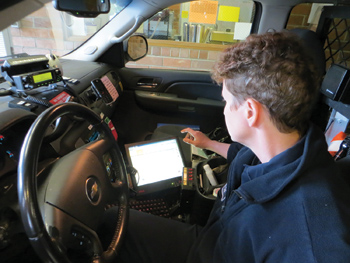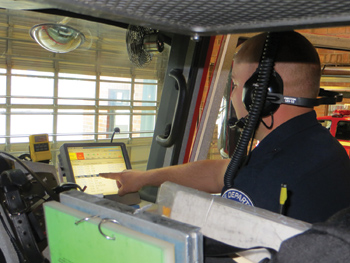Raul A. Angulo
I’ve always been fascinated by the accuracy of futurists like George Orwell, author of 1984. The book, where secret, omnipresent surveillance was a major theme, was first published in 1949. Today’s technology (which is almost alien) would be highly coveted by Big Brother and The Party. For example, the other day my daughter borrowed my car to visit some friends in Tacoma, Washington. A few days later, I got a speeding ticket in the mail from the photo enforcement division of the police department. The photo infraction notice had two photos of my car and read, “The vehicle described above was photographed and determined by in-ground sensors to be in excess of the posted speed limit.” She was going 50 miles per hour (mph) in a 35-mph zone. Think about how fast those components have to operate to sense a vehicle that’s speeding, calculate the wheelbase, and send a signal to the camera to focus and shoot. Well, that technological advancement cost me a whopping $124.
If you look at many military historical battles, what would have made the difference in the outcome? Real-time information. The speed in gathering, processing, interpreting, and sending pertinent information for critical decision making is the crux of current technological advances. Since the fire service is now a component of homeland security, we’re starting to benefit from cutting-edge technology sooner rather than later.
 |
| (1) On large incidents, the incident commander (IC) needs to effectively communicate and share information with crews on scene and other agencies. The onBoard System enables supervisors to view preincidents plans, building diagrams, fire control diagrams, and access/egress routes, as well as other relevant data to make up-to-date critical decisions. (Photos by author.) |
Embracing the Computer Age
In the past five years, we’ve seen tremendous advances in computer technology. Most fire apparatus have mobile data computers (MDCs). They’re almost as standard as steering wheels. Some MDCs have a keyboard and a small monitor, some are laptops, and some have touch screens. But, the program capabilities vary.
MDCs started out as a part of computer-aided dispatch systems (CADs) and were primarily used to receive alarms. The officer would push a button to indicate when the unit was responding, had arrived on scene, and returned to service. That was the extent of it. Today, MDCs do much more. They can show all the current alarms within the jurisdiction, street maps, vehicle locations and tracking, routes of travel, and hydrant locations. They can allow the officer to fill out fire and emergency medical service (EMS) reports in the cab. More programs and applications are coming fast, but there needs to be a network in place to manage the larger data files and the required support systems.
Lenny Roberts, director of Management Information Systems (MIS) for the Seattle (WA) Fire Department, which recently partnered with In Motion Technology Inc. on such a network, says, “In 2011, we responded to 12,709 fire incidents, 45,822 basic life support (BLS) medical alarms, and 18,773 advanced life support (ALS) medical alarms. With 33 fire stations and more than 60 pieces of apparatus, we needed to create a centrally controlled mobile wireless networking system to reduce cost and duplication while increasing security. There is a tremendous cost savings when you have the ability to remotely monitor vehicle health, status, and location; check network connections; and repair and update all the mobile computing devices from a central control. This is only possible with a mobile network technology like the onBoard™ System from In Motion Technology Inc.”
In Motion Technology Inc. is based in New Westminster, B.C., Canada, and is a creator of mobile networking systems. The company has been in existence for 10 years and works with about 400 public safety agencies throughout North America, including transit and utilities.
EMS was the first to benefit from the new mobile network system because it initially had many devices and applications that needed to be connected to some sort of communications network. Consider all the computer systems and communications equipment that go into an ambulance and add all the portable equipment that is used for patient care. In the past, electrocardiogram (ECG) signals were sent to the emergency room (ER) by telephone. Currently paramedics use cell phones, PDAs, or modems to transmit critical information to the ER. These provide a short-term solution for individual devices. Each device requires a separate modem or cell phone, and there’s a financial cost attached to that air time. As the number of devices and applications increases to improve patient care, it becomes apparent that the existing networks can’t provide complete coverage, security, or the ability to support such applications.
Currently, most fire and EMS agencies use an 800-MHz radio network for voice, but it has a narrow bandwidth and is limited when transmitting large data files like audio and video. The future 700-MHz radio spectrum, which has been allocated to public safety, will be equivalent to a commercial long-term evolution (LTE) network and will be suitable for transmitting and supporting large volumes of data. The 700-MHz bandwidth became available when the analog TV spectrum was allocated to public safety based on future data needs. It will evolve into a new, nationwide first responder communications network. That’s why the FCC made the public switch from analog television signals to digital-it needed the space.
 |
| (2) Company officers have the ability to complete fire and EMS patient care forms right from the cab. This information is immediately entered into the database, saving the department time and money. Large video and audio files can be streamed directly to fire units or vice versa. The officer will be able to use a video camera to stream real-time video to the IC and other units and agencies operating at the scene on a single secured network. |
The onBoard System
The In Motion onBoard System consists of three essential components: the onBoard Mobile Gateway, the onBoard Mobility Manager, and the onBoard Connection Manager. Together, the system consolidates all fire and EMS traffic into a single network. Here’s how they work.
The onBoard Mobile Gateway is a high-performance, high-security (built-in), wireless broadband, in-vehicle router. This system network allows for mobile applications by turning any fire or EMS apparatus into a communication wireless hotspot or wireless access point (WAP). It also connects all wired and wireless devices in and around the apparatus securely with the ability to use multiple broadband 3G, 4G, and Wi-Fi networks. The Gateway extends the department network to the fleet, including security layers to ensure reliable flow of information to and from any device or application.
The onBoard Mobility Manager is a network management system that allows the fire department to manage and monitor its mobile networks the same way it manages its land-based office networks that link fire station desktop computers with headquarters. Accessible from any browser, MIS can securely and remotely perform fleet diagnostics, troubleshoot systems and devices, modify configurations, and perform software maintenance and updates across the fleet. It can map network coverage and monitor usage and onboard assets with Wi-Fi tags. It allows the department to track apparatus and vehicle locations in real time. By analyzing real-time and archived GPS information from the onBoard Mobile Gateway, the Mobility Manager can reduce response times and improve citywide coverage and services.
The onBoard Connection Manager is the overall security system. It is a mobile-optimized virtual private network (VPN) server, providing secure Internet protocol (IP) mobility and sub-second switching in a multinetwork environment. Designed to provide continuous connections and enable the use of real-time applications as vehicles roam between multiple wireless networks, it will pick the best wireless network-3G, 4G, or Wi-Fi-for speed and signal strength. It consolidates all applications and traffic into a single network with two levels of device authentication, end-to-end VPN connection, and data encryption. The message and data information remains secure.
 |
| (3) With approximately 65,000 medical alarms a year, Seattle (WA) Fire Department paramedics will now be able to send ECGs, vital signs, and other patient data from defibrillators in real time to ER doctors well before patients arrive at the hospital, expediting critical treatment preparation and improving patient outcomes and survivability. |
Medic Implications
So what does all this mean for paramedics and firefighters? For medics, it’s going to allow them to send vital ECGs and other critical information from their defibrillators to the ER doctor in real time well before the patient arrives at the hospital, expediting critical treatment preparation and improving patient outcomes and survivability. It will also allow audio and video files to be transmitted to the ER. This can be a double-edged sword. Although ER personnel will be able to listen and view the patient’s prehospital condition and treatment, it will also record any errors committed in the field.
In mass-casualty incidents, units can send multiple ECGs as well as electronic patient care forms, bar codes, and medical triage code systems implemented to manage the treatment and transport of patients all on a secure network.
For the administration at headquarters, if billing is part of the system, information can be quickly processed for invoicing. This system saves the department money by going paperless. Handwritten EMS patient care forms can take six weeks to make it through to headquarters and be entered into a database. Automating the medical records using the mobile wireless system will allow the fire department to quickly respond to information requests made from the police, law department, mayor’s office, private attorneys, and insurance companies. To manually locate an EMS form from even two days prior can be a scramble for large departments.
Firefighter Implications
Firefighters need rapid, accurate information to make critical decisions on the fireground. At larger incidents, they need the ability to effectively communicate with a host of agencies while en route and on scene. This system improves communication between headquarters, the fire alarm center, fire units, and other agencies. Firefighters will be able to view prefire plans, building diagrams, bird’s eye view photos and video, hazardous materials locations, access and egress routes, and fire control systems. The information and images can be shared securely in real time with anyone on the network.
With the ability to send audio and video files in real time, the command post, command vehicles, specialty units, EMS, and fire apparatus will all have the ability to stream video images, both sending and receiving, at an incident. That means using helicopter-mounted cameras and helmet cams will allow everyone to see all sides of the building’s exterior, exposures, as well as current conditions inside the structure-all in real time.
Department Implications
Many companies sell modems for vehicles, but In Motion has an infrastructure that supports all applications and wireless networks. By allowing multiple data devices on an apparatus or at an emergency incident scene to share a single secure network connection, the onBoard Mobile Gateway can reduce communication costs. For example, just two in-vehicle devices transmitting data over the Gateway can save up to $750 a year in air time alone. The ability to remotely diagnose, update, and repair systems also saves money.
The Gateway can also be programmed to allow time-sensitive data to travel over cellular high-bandwidth networks but use less expensive Wi-Fi networks to transmit lower priority data, also reducing air time costs.
More Uses on the Horizon
Are these all the applications for firefighters? “Oh no,” says Roberts. “There’s plenty on the horizon. For example, take the Homeland Security/Port of Seattle Security Project. We will have surveillance cameras all along the waterfront from the ship canal to Harbor Island (bulk fuel storage) to Alki Point. During any marine or waterfront incident, these cameras can be aimed, and any view within the cameras’ range can be streamed to the incident command post. This can provide a bird’s eye view perspective as well as allow seeing three sides of the incident. Eventually the cameras will extend throughout downtown and along the Interstate 5 corridor. The current camera systems are part of transit and traffic control. These additional cameras will be part of an enhanced public safety strategy. Some cameras will also have infrared capability, which can help locate heat sources and people through smoke and darkness.”
According to Roberts, this technology will also expand firefighter accountability. “An accountability tracking system will track firefighters and equipment using RF (radio frequency) ID tags attached to SCBA units, helmets, and hoselines. We’ll be able to tell where our people are within a certain perimeter. Practical logistics and money prevent us from having apparatus cams, helmet cams, and tracking systems now, but we’re getting there. Technology is a lot better than it was five years ago. Let’s see where we’ll be in the next five years. In the meantime, the In Motion onBoard System provides firefighters and paramedics with a communication system to transmit critical information quickly, assisting us in providing superior prehospital patient care, improved response times, and real-time information for incident mitigation.”
RAUL A. ANGULO, a veteran of the Seattle (WA) Fire Department and captain of Ladder Company 6, has more than 30 years in the fire service. He is a member of the Fire Apparatus & Emergency Equipment editorial advisory board. He lectures on fire service leadership, company officer development, and fireground strategy and accountability throughout the United States, Canada, and Mexico.

